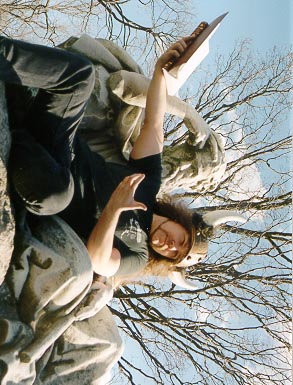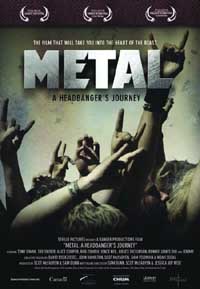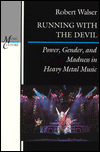The genre that came seemingly last of all the metal genres was the one that considered its ideals the most seriously and consequently, produced a radically distinctive form of music. While black metal was somewhat of the cousin of speed and death metal during its early days, during the 1990s it bloomed into full musical form after developing a philosophy more coherent with its dark aesthetic than the hedonism and liberalism of the past. In a consequent blaze of controversy, the black metal genre streaked across the public perspective briefly before proliferating into a variety of styles and mainstream versions of its sound, forcing older variants out as a flood of similar bands absorbed the genre.
The Early Years
Black metal existed first as a singular concept in aesthetics, and later began to proliferate musically, only differentiating itself from death metal in the theoretical arena when its philosophical divergence became clear to the Norwegians in the early 1990s. A comparison from history can be found in the invention of the telephone; while Alexander Graham Bell invented the phone itself, the complex switching systems necessary to connect multiple parties within a city awaited later inventors. Similarly, the aesthetics [appearance and stylistic refinements of music] of black metal were created long before it really existed as a genre, influencing a period of long lull in the 1980s.
There is confusion as to who “invented” black metal, but it is clear that like death metal, its origins came from the same general area and were spread across creators worldwide contributing to the process. While Venom were the first band to grab headlines with their sensationally stripped down riffing and overtly occultist yet ludicrous image, it was Bathory, Sodom and Celtic Frost who gave the genre its enduring form. Where Venom was limited musically to deconstructed heavy metal, these bands took the neoclassical phrasing and minor key melodies of NWOBHM bands like Angel Witch, Judas Priest and Iron Maiden and matched them up with the droning three-note roar of early crustcore as exemplified by Discharge. As both bands depended on diminished melodies in power chord riffing it was a seamless match.
During this formative era of black metal, several general styles emerged. First was Bathory with a smoothly flowing, fast-tremolo picked flow of sound over consistent throbbing drums; next was Sodom, making three-chord primitivism which moved at high speed with unsteady and abrupt changes of riff, tempo and texture; also included were Hellhammer, who specialized in droning minimalist music that often resembled hardcore punk played in minor keys, and Celtic Frost, the continuation of that band into grandiloquent constructions resembling the musical staging of operatic scenes; finally, there was Venom, who continued to produce their heavy metal/punk hybrid which delighted in using the simplest possible musical devices to convey the broadest changes available.
From this time onward, the genre slept while innovations were made in the death metal camp, with a few notable exceptions soon to be covered. The same year that Bathory unleashed its first opus brought about a small but intense wave of hardcore/metal hybrids front by Slayer but including within the next two years formative works from Sepultura, Possessed and Morbid Angel. While the basic approach of death metal was to create intricate arrangements using extended phrasing in an architectural style, its essential approach involved rhythm and chromatic progressions which did not admit much obvious melody. The tightly-woven, complex and interlocked riffing used by early death metal bands produced a sense of deconstruction and immersion but gave little new direction. As the genre wound up for its grand entrace, black metal again split from the pack in the 1987-1988 era with Sarcofago and Mayhem, and was then silent for another four years while death metal raged.
Sarcofago presented something offensive, abrupt and even ludicrous to people of the time who were schooled in the riff salad style of death metal, with stilted and broken sounding rhythm changes matching akward, nearly imbecilic riffs which fit together into songs with an uncanny, barely discernible continuity. While the majority of the formative work of Sarcofago, “I.N.R.I.,” was abrasively disassociative rhythm riffing, the album held itself together with some admirably sonorous yet barely logical melodies, seemingly as if formulated on a whim by demons of a distracted but perversely insightful mentality. Ignored at the time by most, Sarcofago in part generated the impetus toward the bizarre and primitive that spurred the next generation of black metal into action.
Simultaneous to the release of “I.N.R.I.” was the fourth release from Sweden’s Bathory, “Blood, Fire, Death,” in which the rippingly fast and simple works of earlier albums had been turned into theatrical yet emotive quasi-operatic pieces in which rasping vocals and singing coincided and song structures staged dramatic encounters of their parts more than repeating cyclic patterns. Across the water in Norway, Mayhem were putting the finishing touches on a massively incompetent but enigmatic work known as “Deathcrush,” in which tortuous guitar patterns arced over drumming with the grace of an exhausted pack animal, and horrific howling vocals textured the mix. The following year, Merciless assembled “The Awakening,” a fast speed metal album with touches of death but an undeniably morbid melodic sensation. Together these releases defined what would go into the mix of the genre coming next: the aggression and grandeur of Bathory, the abrupt and convoluted structures of Sarcofago, the rough aesthetic of Mayhem and the dramatic staging of Celtic Frost, who had just unleashed their discontiguous but impressive masterpiece “Into the Pandemonium.”
The Modern Era
Again some years went by in which death metal was the primary focus of the community and fans. Where mainstream metal had vanished under the dual onslaught of grunge and the progressive selling out of speed and heavy metal bands like Metallica and Testament, the underground shot to the forefront of the minds of those who expected metal, and consequently, became the area where development in metal occurred while the more popular bands did their best to reiterate their essential sound and presence as a means of not losing ground. As death metal became more accepted, however, it became slowly infested with the same mentality that clogged mainstream metal: an underconfident, socially dependent, accepting and undiscriminating mentality which placed excellent bands next to derivative, unimaginative acts without thinking twice.
Born of the desire to surpass this mess, the modern era of black metal began in Norway with the first releases from Darkthrone, Immortal, Emperor, Burzum and Mayhem. Each differed from the death metal before it in an emphasis on melodic composition and intricate, classically-inspired song structures which functioned as motifs, returning to not verses or choruses but clusters of riffs and musical ideas which framed their concepts in a setting, not unlike the work of an opera or ancient Greek tragedy. This new form of metal was more vivid and emotionally evocative than the thunderous assault of death metal, and also less concerned with the immediate social values around it; it embraced independent thinking, a dislike for all social dogmas and humanism, a Romanticist love of nature and predation, and a penchant for fantasy and thoughts of ancient times.
The reaction of the death metal boy’s club was unanimous: “fags!” However, the new style rapidly gained ground and soon a second generation of the modern era, including bands like Ancient, Gorgoroth, Graveland, Behemoth, Abigor and Gehenna among others landed in the crowd. Many of these bands were inspired as were original black metal pioneers Darkthrone by the melodic tremolo picking of Swedish death metal bands from the previous generation, which caused the pace to be picked up as the aggression, but the fundamental differences remained. From the reaction to the first wave of black metal, and a desire to get “purer” and farther away from the possible infestation of death metal bands, black metal bands starting with Darkthrone on “Ablaze in the Northern Sky” began to use a fuzzed-out, lo-fi sound and primal song structures similar to those of Hellhammer, early Bathory, and Venom.
While this initially drove away the more sycophantic fans, it was a failing strategy for the same reasons it failed in the production of hardcore music: it made the genre extremely easy to emulate. As demonstrated by bands such as Dark Funeral, it was easy to transition from death metal and make primitive and fast melodic black metal songs which sold in the underground, and soon there were more ex-death metal, ex-crustcore and ex-rock personnel surging into the scene. By the time of the middle 1990s, bands such as The Abyss and Marduk had joined the party, creating in their process templates which any bands could use to emulate the style – and did.
In a few short years the genre had gone from a handful of bands making distinctive music to a horde of bands making indistinguishable music identified only by novelty factors of instrumentation, voice and concept. Nothing was any longer being achieved in the central group of black metal bands, so most of the “old guard” of Norwegian bands backed out and allowed their music to dissipate, as indicated by Darkthrone claiming their “Total Death” album would be final one from the band. As the hordes of scenesters and clone rock artists gathered, bands such as Graveland, Summoning and Ildjarn began experimenting in ambient forms of the original style, writing longer melodies and integrating semi-symphonic instrumentation in digital form in some cases and making rawer, less rock-like music in the case of Ildjarn.
The Drama
Much has been said about the dramatic entry of the Norwegian scene in the early 1990s. Articles ranting about the terror the “Inner Circle” and “Black Circle” would bring to Christian society overstated the case, and so by the year 2000 most fans were tired of hearing the same stories of the genesis of the scene. These will be mentioned here only for the purpose of conveying the ideology of black metal, and its effect upon society at large that in turn reflected the response of civilization to black metal and some of the factors that contributed to its demise.
In the beginning, there were a handful of black metal bands in Norway loosely unified around some ideals and a few meeting places, including the shop Euronymous from Mayhem ran called Helvete [Hell]. There is some debate over whether or not there was a formal “Black Circle” as initially was claimed by American and British publications, but clearly the members of these bands communicated and met within the 4.5 million person country. Strange things began happening in Norway: churches burned, a homosexual man was slit open, miscellaneous assaults and grave desecrations occurred, and then to cap it off, Euronymous was stabbed one night in his apartment. Furthermore, implications of fascism and/or Nazi beliefs were pointed at many members of the underground, most of whom quickly denied them.
First, the vocalist Dead of Mayhem committed suicide with a large knife and shotgun, leaving a note “Excuse all the blood.” Some time later, Varg Vikernes of Burzum was arrested for burning churches and murdering Euronymous; at the time of this writing, he is still serving his term [when arrested, Vikernes was near famished from lack of money to buy food, yet had 150kg of explosive in his basement for use in destruction of churches]. Over 20 other black metal musicians and fans were arrested for burning churches; a total of 77 burned in Scandinavia during that time, although not all have been definitively linked to “Satanists.” Several other musicians did time for killings, assaults, desecrations or unrelated arsons, including Jon Notveidt in Sweden who served 8 years for being accessory to a killing, and Hendrik Moebus in Germany, who served several years as accessory to a murder before being arrested for making a Roman salute while on parole. While the carnage was not widespread, the effect was; Europe saw a wakeup call to some Pagan values and anti-Judeo-Christian sentiment, and America saw a chance at rebellion and consequently, marketing.
Further, the community of black metal had a chance to demonstrate its values. While most members of the scene when pressed denied they had been involved in fascist or Nazi politics, they were indifferent to the roles of others in such things. Equally noncommittal were many around Euronymous after his murder; Hellhammer, the drummer of Euronymous’ band Mayhem, shrugged and said, “One of them had to die,” when queried about the feud between Vikernes and Euronymous. Most bands interviewed spoke positively of nature, negatively of Christianity, and displayed disdain for social behavior that placed the lives of individuals above that of a collective movement. This made many uneasy, especially in tolerant, peaceful and normally quite uneventful Scandinavia.
The Aftermath
When the mainstream bands such as Dimmu Borgir, Cradle of Filth and Marduk that attracted hundreds of thousands to black metal are confronted with the ideology of the founders of modern black metal, they quickly shake their heads and walk away. “Not for us, thanks.” In addition, their music is fundamentally different from that of the underground bands; where the originators of this style used diatonic and chromatic riffs and melodic modes, most of the “aboveground” black metal uses pentatonic scaling and much of the same riffs and rhythms of metal bands from the 1970s. Thus is exemplified a split in the genre: the bands who are doing what metal bands always have, and the bands who are moving away from traditional metal toward a more neoclassical, less rock-n-roll, more intricate musical form.
This split extends to every area of the black metal scene at the time of this writing. On one side, let’s call it the “left,” there are bands who embrace the current era and its variant aesthetics, including the mainstream genres outside of metal; a good example here would be Ulver or Sigh, both of who create postmodern metal from fragments and samples of other genres arranged into pieces delineated by key or rhythm. On the right would be the classicists, the old-schoolers who either only support black metal in the established tradition or who embrace a “purity” of both musical rawness and ideological allusion to the Greco-Roman, Viking or fascist values. For all intents and purposes this split is permanent, with the sides diverging into assimilation on the left and obscurity on the right, yet somehow they keep attracting audience, albeit a degraded one.
Some would say that there was a mystique about black metal that took a long time to die; it didn’t break in 1996, when The Abyss made an album so textbook Norwegian black metal that it provided a template for other bands to follow, and it didn’t even break in 1998 when all but a handful of the original bands had moved on to making more contented music. The year after however appears to have brought the death of black metal in a form emerging from within, similar to the story of Baldr’s death that conceptualizes a later Burzum album: betrayal from within. When the first of the more mainstream bands emerged, the underground took a clue from Darkthrone and it became de rigeur for the non-commercial bands to slap out albums with monochrome art and blindingly distorted, low-technicality music. As before however, this made it easy for further emulation to occur, diluting a genre with exactly what it opposed, and turning it from a movement where concept, music and action were joined into another form of entertainment for couchbound teenagers.
Black Metal Belief Systems
Conventional wisdom in the Judeo-Christian west holds that nature is lawless, dangerous and pointless; to give life meaning, there must be a moral goal, such as civilization itself: the conquering of natural frontiers and environments, taming of natural impulses in humans, and reduction of the law of the fittest – an equalization, as F.W. Nietzsche and later others pointed out. Nietzsche saw this equalization as a form of “revenge” on nature by depriving nature of what makes it threatening to the individual human, namely the potential imminent death – a form of judgment – for being less than capable in a situation calling for endurance and survival.
Sixty years after Nietzsche’s most influential period of work, explosions on the Polish border awakened the globe to the second world war. In this war, a conflict between the most fundamental division of ideology was established: collectivism versus individualism, with the latter favoring the kind of product-oriented, technologically-based, container-logical lifestyles currently seen in the first world nations. It was those insular and self-pleasing ways of living that first irked black metallers, and demonstrated to them a social devolution: there was no longer any competence needed, only obliviousness. Many black metallers, like Nietzsche, found greater inspiration in nature than in post-Judeo-Christian western society, and identified what Christians find horrible – the bloody, competitive, anti-individualist character of nature – to be an example of the most sublime beauty.
The ideological inclination of black metal remains disturbing to most and illegal in many countries. Yet it is not unique to black metal; as history shifted in the 1960s from a predominantly conservative society to a liberal society, thanks to the counterculture, and its effects were only felt with the children growing up in the 1980s, their response mirrors that of some who rejected the flower powery view of the politics and society. Among the thinkers and dissidents now coming back into favor are ecological fascists like Pentti Linkola and Theodore Kaczynski, as well as various stripes of nationalist and racial separatist leaders. [The Anti-Defamation League, a Jewish self-defense organization, claims that National Socialist and Neo-Nazi movements are increasing “worldwide.”] It’s hard to see what the future holds but this controversy remains in the forefront of not only black metal, but international politics, as shown by the amount of air time it is given by the entertainment industry, news media and American/U.N. politicians.
Interestingly, black metal joins not only the far right, but the far left, in many of its sentiments. As the world anti-globalist and anti-capitalist movement picks up speed, it echoes many of the ideals of black metal: natural ecosystems; ethnic uniqueness; population control; an end to technology-driven, product-oriented, convenience-based lifestyles. Protestors across the world in anti-war and anti-globalism protests would be shocked to know they have something in common with a group of bloodthirsty church-burning fascists who idealize the occult, but perhaps would be glad at least for a sympathetic ear. Interestingly also, the “modern primitives” movement as seen in events like the Burning Man festival and the survivalist trend around the time of Y2K align themselves in the same general direction these ideals seem to be taking, but the final synthesis has not yet been heard.
Subdivisions
After the initiation of modern black metal in the Scandinavian style, a fragmentation occurred along the general lines of techniques used to unify song composition, creating a number of subdivisions in the black metal subgenre [genre = metal, subgenre = black]. The following are general descriptions of these substyles and what they implied for changes in black metal as a whole.
Rock
The heavy metal style of black metal, descended directly from Venom and NWOBHM bands like Angel Witch who inspired them, is essentially rock music with some neoclassical influences in the loosest sense. Pentatonic, verse chorus music that stays within basic harmony, heavy metal/rock-styled black metal is recognizable for its radio friendly ways, redundant harmonic constructions and verse/chorus arrangements. Good examples include Venom of course, Dimmu Borgir albums after Stormblast, Cradle of Filth and Dissection.
Raw
Descended from Hellhammer and some early Bathory, this is mostly rhythm music which like hardcore punk is fashioned from the harmonic space of a basic interval between two anchoring notes, often a fifth. While this style is easy to do, it is difficult to do well, as the number of bands emulating Hellhammer and falling far short of what Hellhammer produced have found.
Epic
Symphonic styles and epic song structures often seem to go together, as seen in bands like Summoning, Graveland, Heidenreich and early Emperor. Where most bands indulge some complexity, these bands aspire to a demi-operatic state of unifying concept with staging, projecting a theatrical view of the action described in a song through the pure sound and arrangement of riffs. These bands are often the closest to classical music in types of melody and depth of layering, but it is important to note that epic is mainly a description of the complexity and arrangement of a band, not its techniques, so there is complete overlap with other styles mentioned here.
Trance
Music designed to utilize the undulating nature of the sweep picking of a guitar as suspended between unchanging percussion of a basic nature, this style is inspired by generations of metal with ambient experimentation, including Slayer, Von, Massacra, and Bathory. The most notorious band working in this group is Burzum, but other bands such as Nargaroth, I Shalt Become, Ildjarn and Darkthrone have created great works in this area.
Melodic
The oldest style of modern black metal, the melodic compositional approach was first utilized by Norwegian bands looking for a way to make simple power chord music more than thudding rhythm and chromatic patterns. Immortal’s “Pure Holocaust” is the best example of this, with highspeed tremolo picking whipping distorted noise into a flood of searing yet beautiful sound, but there are also examples to be found in Behemoth, Darkthrone, Mayhem and Sacramentum.
No CommentsTags: Black Metal, metal history
 To most, it seemed like an excessively dischordant voice. After all, the good times had arrived — hadn’t they? The big evil was gone, and only good remained, and with our new good intentions for all — liberalism — we were sure to make friends, raise the wealth of the world to our level, and (some assumed) end war, suffering, tragedy, racism and religious hate forever. Black metal idealized all of those things and to most at first seemed a movement for lost teenagers looking for an identity outside of the suburban lifestyle sure to assimilate them.
To most, it seemed like an excessively dischordant voice. After all, the good times had arrived — hadn’t they? The big evil was gone, and only good remained, and with our new good intentions for all — liberalism — we were sure to make friends, raise the wealth of the world to our level, and (some assumed) end war, suffering, tragedy, racism and religious hate forever. Black metal idealized all of those things and to most at first seemed a movement for lost teenagers looking for an identity outside of the suburban lifestyle sure to assimilate them. To a Romantic, Wal-Mart is hell and there is no heaven.
To a Romantic, Wal-Mart is hell and there is no heaven.





 For the first video review to ever grace these pages a film was chosen that is valuable for the conclusions gleaned from its perception, and not necessarily the art of moviemaking exhibited. Following the pattern of most first films, this work starts with a group of characters and mocks them in their ouroboric paths to nowhere. In doing so, it reveals something of the nature of the metal community itself, both through its dominant symbols – drugs, masturbation, anger, fatalism – and through its own fascination and the conclusion it is able to draw. Shot in conveniently sparse videocam, the movie romps through a series of goofy but enjoyable skits and long derangements of the senses synchronized in form to music, giving it the feeling of a music video + home video + low-budget film in one. Of note are musical choices, which showcase a DJ’s eye for context. There is ample T&A of a tame variety and gratifying indulgence in all forms of base humor, including masturbation, fecalism and amusing violence. Highlights include a series of blown-out female characters who are preachy but have the sexual ethics of a Grimoire Girl(tm), a fantastically fascist cop played by Craig Pillard, and several utterly believable stoner/metalhead characters who wander around in a haze of mostly their own creation. Absent is any moralism regarding the world around us; it is nice to escape that moralistic confine in which most contemporary filmic art is launched. Another highlight is “Ox,” who barges his way onto the set and provides one of the most believable character satires of pure rampaging destruction in human form yet found. Toward the beginning and end of the film, when it needs extra impetus, there is booster rocket material from what are now basic digital editing effects, which to the director’s credit are often quite cleverly applied (“making the most of what you have”). Is the movie “good”? No and yes. It’s hard to sit through some of this; the scenes are long and often tediously embarrassing to the degree that sympathy is lost for the characters and even the joke. As a whole, the plot is light, with three or four major devices and a linear narrative based on its precepts. It’s sometimes difficult to watch from a combination of ineptitude and padding. However, it is “good” in that this movie has a large amount of perceptive content for a cut-up laugh fest, and while its methods and often gags are cheap and sometimes predictable, they’re carried out with a unique flair and nurture for the humor involved. Like any modern comedy, the plot is a container for almost granularized skits woven roughly into the context of the people who drive changes in the action, and this approach works for the scattershot method required to address the diverse complexity of intellectual representation of external reality in this era. The acting isn’t great, but Zebub himself is a high-energy riot of comedic momentum who can be witty in a pinch, or subtly humorous over the length of a scene. His supporting cast perform well compared to many card-carrying actors and, while like in the movie itself we can see rough edges there are imperfections galore, they link up in the film like prisoner sex. While this movie gets a somewhat ambivalent recommendation, the idea of pursuing the next professional offering from Bill Zebub is not at all ambiguous to this reviewer.
For the first video review to ever grace these pages a film was chosen that is valuable for the conclusions gleaned from its perception, and not necessarily the art of moviemaking exhibited. Following the pattern of most first films, this work starts with a group of characters and mocks them in their ouroboric paths to nowhere. In doing so, it reveals something of the nature of the metal community itself, both through its dominant symbols – drugs, masturbation, anger, fatalism – and through its own fascination and the conclusion it is able to draw. Shot in conveniently sparse videocam, the movie romps through a series of goofy but enjoyable skits and long derangements of the senses synchronized in form to music, giving it the feeling of a music video + home video + low-budget film in one. Of note are musical choices, which showcase a DJ’s eye for context. There is ample T&A of a tame variety and gratifying indulgence in all forms of base humor, including masturbation, fecalism and amusing violence. Highlights include a series of blown-out female characters who are preachy but have the sexual ethics of a Grimoire Girl(tm), a fantastically fascist cop played by Craig Pillard, and several utterly believable stoner/metalhead characters who wander around in a haze of mostly their own creation. Absent is any moralism regarding the world around us; it is nice to escape that moralistic confine in which most contemporary filmic art is launched. Another highlight is “Ox,” who barges his way onto the set and provides one of the most believable character satires of pure rampaging destruction in human form yet found. Toward the beginning and end of the film, when it needs extra impetus, there is booster rocket material from what are now basic digital editing effects, which to the director’s credit are often quite cleverly applied (“making the most of what you have”). Is the movie “good”? No and yes. It’s hard to sit through some of this; the scenes are long and often tediously embarrassing to the degree that sympathy is lost for the characters and even the joke. As a whole, the plot is light, with three or four major devices and a linear narrative based on its precepts. It’s sometimes difficult to watch from a combination of ineptitude and padding. However, it is “good” in that this movie has a large amount of perceptive content for a cut-up laugh fest, and while its methods and often gags are cheap and sometimes predictable, they’re carried out with a unique flair and nurture for the humor involved. Like any modern comedy, the plot is a container for almost granularized skits woven roughly into the context of the people who drive changes in the action, and this approach works for the scattershot method required to address the diverse complexity of intellectual representation of external reality in this era. The acting isn’t great, but Zebub himself is a high-energy riot of comedic momentum who can be witty in a pinch, or subtly humorous over the length of a scene. His supporting cast perform well compared to many card-carrying actors and, while like in the movie itself we can see rough edges there are imperfections galore, they link up in the film like prisoner sex. While this movie gets a somewhat ambivalent recommendation, the idea of pursuing the next professional offering from Bill Zebub is not at all ambiguous to this reviewer. I just saw this at the Alamo Drafthouse, and I was surprised at how much I enjoyed it. It is probably the most watchable movie on the topic thus far, as it actually has a budget and properly addresses the many subgenres. It stays focused on the more populist bands (Wacken is a prominent setting) but I find that getting into all the underground minutiae bottoms out these days because whether people are motivated by commerce or popularity, the effect on the music is just as deletrious. Sam Dunn, the filmmaker, is a contemporary of the 1980s metal (30-ish, grew up on thrash and death metal, cites Autopsy as one of his favorite bands) so it is worth supporting and good fun. The interview with Gaahl and then Dio repeatedly ripping on Gene Simmons are worth the price of admission.
I just saw this at the Alamo Drafthouse, and I was surprised at how much I enjoyed it. It is probably the most watchable movie on the topic thus far, as it actually has a budget and properly addresses the many subgenres. It stays focused on the more populist bands (Wacken is a prominent setting) but I find that getting into all the underground minutiae bottoms out these days because whether people are motivated by commerce or popularity, the effect on the music is just as deletrious. Sam Dunn, the filmmaker, is a contemporary of the 1980s metal (30-ish, grew up on thrash and death metal, cites Autopsy as one of his favorite bands) so it is worth supporting and good fun. The interview with Gaahl and then Dio repeatedly ripping on Gene Simmons are worth the price of admission. What is excellent about this documentary is its bonehead simplicity in tracing the history of metal. It focuses on nodal points where single events touched off nascent convergences and caused paradigm shifts. Not all of these are musical events; much of the footage is devoted to showing how changes in history prompted changes in metal. This attitude allows it to peer into the motivation behind metal musicians more than any other documentary extant. The strength of this documentary is its star power in pulling in all of the classic figures in heavy metal for interviews. The big names show up, and get put at ease and asked questions by people whose journalistic intent matches a fascination with rock music as an event. When their answers are put in context, the result is metal history like a scrolling tapestry passing our eyes. The centerpiece of this documentary are the glam years of Hollywood bands from Van Halen to Guns and Roses, and much of it is intended to make them look more sophisticated and intense than their European counterparts who invented the genre. Speed metal gets an offhand mention, and underground metal gets entirely skipped. Its focus is not surprisingly on the kind of metal that makes it to the VH1 video channel and makes pots of money. In its coverage of glam rock, power ballads, bad boy rebels and drug abuse this film is most lucid. Humorously, the glam rockers, twenty years later, look somewhat diseased, while Tommy Lee still looks vile and combat-ready. Even funnier: of all the people interviewed, a remarkably self-confident and unpretentious Sebastian Bach is the most articulate and uncomplicated. Unfortunately, other parts of the film portray metalheads as wounded, out-of-control children who make this horrible, violent music because they’re defective. While these flaws weaken the documentary, and disable it more in post-viewing analysis when the viewer realizes the documentary’s weaknesses stem from a desire to productize one of the last un-zombie’d genres, “Heavy: The Story of Metal” has many positive factors, not least of all the simplest: the people who made it clearly enjoy metal music and wanted to portray it in a positive light, even if their definition of positive was twisted by their pocketbooks.
What is excellent about this documentary is its bonehead simplicity in tracing the history of metal. It focuses on nodal points where single events touched off nascent convergences and caused paradigm shifts. Not all of these are musical events; much of the footage is devoted to showing how changes in history prompted changes in metal. This attitude allows it to peer into the motivation behind metal musicians more than any other documentary extant. The strength of this documentary is its star power in pulling in all of the classic figures in heavy metal for interviews. The big names show up, and get put at ease and asked questions by people whose journalistic intent matches a fascination with rock music as an event. When their answers are put in context, the result is metal history like a scrolling tapestry passing our eyes. The centerpiece of this documentary are the glam years of Hollywood bands from Van Halen to Guns and Roses, and much of it is intended to make them look more sophisticated and intense than their European counterparts who invented the genre. Speed metal gets an offhand mention, and underground metal gets entirely skipped. Its focus is not surprisingly on the kind of metal that makes it to the VH1 video channel and makes pots of money. In its coverage of glam rock, power ballads, bad boy rebels and drug abuse this film is most lucid. Humorously, the glam rockers, twenty years later, look somewhat diseased, while Tommy Lee still looks vile and combat-ready. Even funnier: of all the people interviewed, a remarkably self-confident and unpretentious Sebastian Bach is the most articulate and uncomplicated. Unfortunately, other parts of the film portray metalheads as wounded, out-of-control children who make this horrible, violent music because they’re defective. While these flaws weaken the documentary, and disable it more in post-viewing analysis when the viewer realizes the documentary’s weaknesses stem from a desire to productize one of the last un-zombie’d genres, “Heavy: The Story of Metal” has many positive factors, not least of all the simplest: the people who made it clearly enjoy metal music and wanted to portray it in a positive light, even if their definition of positive was twisted by their pocketbooks. Aimed at the most popular examples of heavy metal, this analysis peers into issues of gender and power as ethnographic vectors of impetus toward participation in the metal genre. The interpretations of reasoning and ideologies behind music, while limited to less than self-articulate examples in many cases, are the strength of this book.
Aimed at the most popular examples of heavy metal, this analysis peers into issues of gender and power as ethnographic vectors of impetus toward participation in the metal genre. The interpretations of reasoning and ideologies behind music, while limited to less than self-articulate examples in many cases, are the strength of this book.
